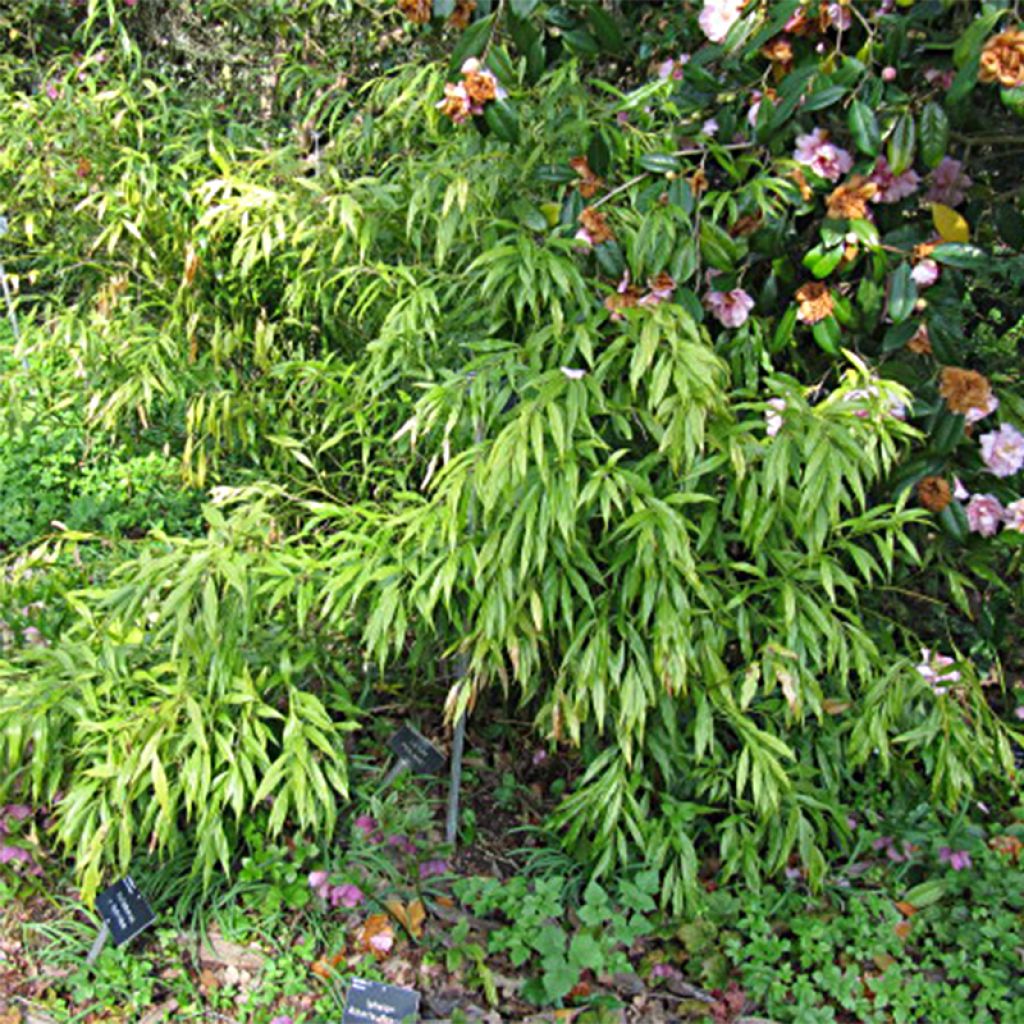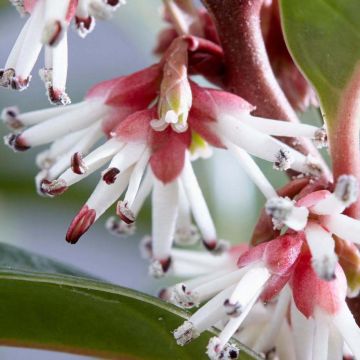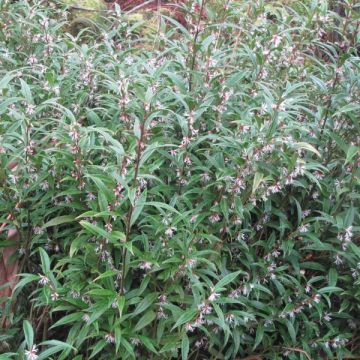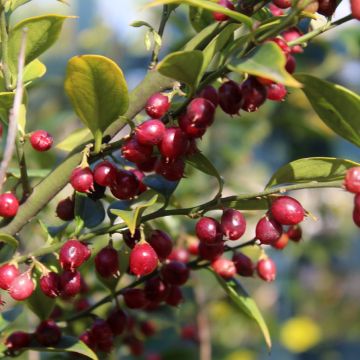

Sarcococca saligna - Sarcocoque à feuilles de saule
Sarcococca saligna
Sarcococca saligna
White-stem Sweet Box, Willow-leaved Sweet Box
One of the latest arrivals, with magnolia stellata, arrived fresh and in very good condition!! The promise of flowers from this amazing seller's website is truly top-notch, they really take great care of their plants. Well done and thank you!
Anne-Marie, 01/03/2022
Special offer!
Receive a €20 voucher for any order over €90 (excluding delivery costs, credit notes, and plastic-free options)!
1- Add your favorite plants to your cart.
2- Once you have reached €90, confirm your order (you can even choose the delivery date!).
3- As soon as your order is shipped, you will receive an email containing your voucher code, valid for 3 months (90 days).
Your voucher is unique and can only be used once, for any order with a minimum value of €20, excluding delivery costs.
Can be combined with other current offers, non-divisible and non-refundable.
Home or relay delivery (depending on size and destination)
Schedule delivery date,
and select date in basket
This plant carries a 24 months recovery warranty
More information
We guarantee the quality of our plants for a full growing cycle, and will replace at our expense any plant that fails to recover under normal climatic and planting conditions.
Would this plant suit my garden?
Set up your Plantfit profile →
Description
Sarcococca saligna, also known as willow-leaved sweet box, is a Himalayan botanical species rather rare in cultivation, but easy to grow in cool climates and soil. This beautiful evergreen bush is distinguished by its slender and elongated foliage, resembling that of willows, but also because its winter flowering is almost odourless, an unusual trait within the genus. With a spreading but compact habit, it carries its large leaves like a cascade of feathered mantle on its arching branches. The discreet winter flowering is followed by decorative small purple fruits. Perfect for shade or semi-shade, this medicinal plant settles among the roots of trees, slowly but surely.
Sarcococca saligna is a branching rhizomatous shrub belonging to the Buxaceae family, a close relative of boxwood, native to the Himalayas, from northern Pakistan, through Nepal, Afghanistan, and down to India, growing at altitudes ranging from 1200 to 1300 m (3937 to 4265ft). It is commonly found in the evergreen forests of these regions. It is a small dense, slow-growing shrub with a compact habit and green, arching stems, which will not exceed 1.20 m (4ft) in height and 1 m (3ft) in width after many years. Its original foliage is persistent and leathery. It is shiny light green on the upper side and even lighter underneath. The leaves are entire, oblong-lanceolate, very elongated; they measure 6-9 cm (2-4in) long by 1.2-2 cm (1in) wide. The flowers appear from December, sometimes alongside the black fruits forming a very nice contrast. They are gathered in short clusters in the axils of the leaves, all along the branches. They measure no more than 3 to 5 mm (1in) in length and are devoid of petals, showing only very developed pale yellow-green stamens. This barely scented flowering lasts for about 2 months, depending on the climate. The fruits are 1 cm (1in) ovoid, purple berries which become almost black and shiny in autumn.
Very hardy, this sarcococca seems to be one of the easiest to acclimatize in our gardens, as it is not very demanding on soil type and exposure. Although it grows slowly, like dwarf conifers, it knows how to blend into the background during the summer season, but effectively structures small spaces in winter and requires little care. It has the advantage of bringing a touch of spring to the garden throughout the winter, just like mahonias. It can be cultivated in flower beds as well as in woodlands, low hedges or ground cover. It only dislikes really chalky soils and is perfectly capable of competing with tree roots. It is perfect for filling an understory with ferns, witch hazels, skimmias, aucubas or azaleas. You can even grow it in pots.
Used for a long time in traditional Pakistani medicine, it appears, according to very recent studies, that Sarcococca saligna contains very interesting alkaloids for the treatment of pain and cardiovascular diseases, as well as active molecules against certain bacteria and fungi.
Report an error about the product description
Sarcococca saligna in pictures




Plant habit
Flowering
Foliage
Botanical data
Sarcococca
saligna
Buxaceae
White-stem Sweet Box, Willow-leaved Sweet Box
Himalayas
Other Sarcococcas
View all →Planting and care
Sarcococca are so undemanding that they are often reserved for dry and shady corners of the garden. However, they are much more beautiful in coastal climates, in rather cool and well-drained humus-rich soil (their roots do not like stagnant humidity). They appreciate partially shaded areas, sheltered from cold and dry winds that spoil their flowering, and do not mind the presence of tree roots. This bush requires little maintenance and likes to be forgotten. After flowering, prune lightly by removing branches that compromise its symmetry. If the winter were to damage the foliage, the plant would easily regrow from the stump.
Planting period
Intended location
Care
-
, onOrder confirmed
Reply from on Promesse de fleurs
Similar products
Haven't found what you were looking for?
Hardiness is the lowest winter temperature a plant can endure without suffering serious damage or even dying. However, hardiness is affected by location (a sheltered area, such as a patio), protection (winter cover) and soil type (hardiness is improved by well-drained soil).

Photo Sharing Terms & Conditions
In order to encourage gardeners to interact and share their experiences, Promesse de fleurs offers various media enabling content to be uploaded onto its Site - in particular via the ‘Photo sharing’ module.
The User agrees to refrain from:
- Posting any content that is illegal, prejudicial, insulting, racist, inciteful to hatred, revisionist, contrary to public decency, that infringes on privacy or on the privacy rights of third parties, in particular the publicity rights of persons and goods, intellectual property rights, or the right to privacy.
- Submitting content on behalf of a third party;
- Impersonate the identity of a third party and/or publish any personal information about a third party;
In general, the User undertakes to refrain from any unethical behaviour.
All Content (in particular text, comments, files, images, photos, videos, creative works, etc.), which may be subject to property or intellectual property rights, image or other private rights, shall remain the property of the User, subject to the limited rights granted by the terms of the licence granted by Promesse de fleurs as stated below. Users are at liberty to publish or not to publish such Content on the Site, notably via the ‘Photo Sharing’ facility, and accept that this Content shall be made public and freely accessible, notably on the Internet.
Users further acknowledge, undertake to have ,and guarantee that they hold all necessary rights and permissions to publish such material on the Site, in particular with regard to the legislation in force pertaining to any privacy, property, intellectual property, image, or contractual rights, or rights of any other nature. By publishing such Content on the Site, Users acknowledge accepting full liability as publishers of the Content within the meaning of the law, and grant Promesse de fleurs, free of charge, an inclusive, worldwide licence for the said Content for the entire duration of its publication, including all reproduction, representation, up/downloading, displaying, performing, transmission, and storage rights.
Users also grant permission for their name to be linked to the Content and accept that this link may not always be made available.
By engaging in posting material, Users consent to their Content becoming automatically accessible on the Internet, in particular on other sites and/or blogs and/or web pages of the Promesse de fleurs site, including in particular social pages and the Promesse de fleurs catalogue.
Users may secure the removal of entrusted content free of charge by issuing a simple request via our contact form.
The flowering period indicated on our website applies to countries and regions located in USDA zone 8 (France, the United Kingdom, Ireland, the Netherlands, etc.)
It will vary according to where you live:
- In zones 9 to 10 (Italy, Spain, Greece, etc.), flowering will occur about 2 to 4 weeks earlier.
- In zones 6 to 7 (Germany, Poland, Slovenia, and lower mountainous regions), flowering will be delayed by 2 to 3 weeks.
- In zone 5 (Central Europe, Scandinavia), blooming will be delayed by 3 to 5 weeks.
In temperate climates, pruning of spring-flowering shrubs (forsythia, spireas, etc.) should be done just after flowering.
Pruning of summer-flowering shrubs (Indian Lilac, Perovskia, etc.) can be done in winter or spring.
In cold regions as well as with frost-sensitive plants, avoid pruning too early when severe frosts may still occur.
The planting period indicated on our website applies to countries and regions located in USDA zone 8 (France, United Kingdom, Ireland, Netherlands).
It will vary according to where you live:
- In Mediterranean zones (Marseille, Madrid, Milan, etc.), autumn and winter are the best planting periods.
- In continental zones (Strasbourg, Munich, Vienna, etc.), delay planting by 2 to 3 weeks in spring and bring it forward by 2 to 4 weeks in autumn.
- In mountainous regions (the Alps, Pyrenees, Carpathians, etc.), it is best to plant in late spring (May-June) or late summer (August-September).
The harvesting period indicated on our website applies to countries and regions in USDA zone 8 (France, England, Ireland, the Netherlands).
In colder areas (Scandinavia, Poland, Austria...) fruit and vegetable harvests are likely to be delayed by 3-4 weeks.
In warmer areas (Italy, Spain, Greece, etc.), harvesting will probably take place earlier, depending on weather conditions.
The sowing periods indicated on our website apply to countries and regions within USDA Zone 8 (France, UK, Ireland, Netherlands).
In colder areas (Scandinavia, Poland, Austria...), delay any outdoor sowing by 3-4 weeks, or sow under glass.
In warmer climes (Italy, Spain, Greece, etc.), bring outdoor sowing forward by a few weeks.

















































